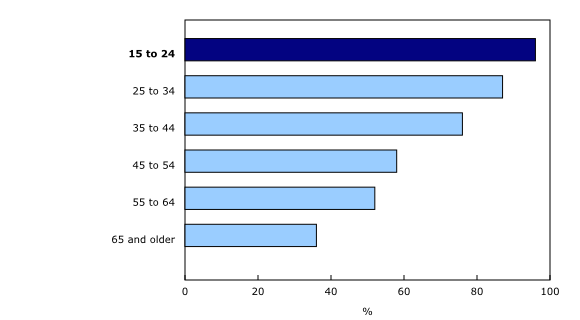General Social Survey: Social identity, 2013
Archived Content
Information identified as archived is provided for reference, research or recordkeeping purposes. It is not subject to the Government of Canada Web Standards and has not been altered or updated since it was archived. Please "contact us" to request a format other than those available.
Released: 2014-12-23
The holiday time often means getting together with family and friends. A new survey, conducted in 2013, indicates that more than half (55%) of Canadians aged 15 years and older felt close to at least five family members, and 51% reported having five or more close friends.
Very few Canadians (4%) reported having no close relatives and a similar proportion (6%) reported no close friends.
Besides close family and friends, Canadians reported a large network of 'other' friends, neighbours and acquaintances. In 2013, 47% of Canadians reported having at least 20 'other' friends.
Young adults tended to have larger social networks. People under the age of 25 had a median of 24 'other' friends, while those between 25 and 34 years old had a median of 20 friends. In general, the older the person, the smaller the circle of friends, as the figure drops to 15 friends between the ages of 45 and 54, and to 10 friends for those aged 65 years and older.
One possible reason for the larger circle of friends in younger years may relate to the greater likelihood of meeting new people. In 2013, 6 in 10 Canadians under 35 years old indicated that they met someone new in the month prior to the survey with plans of keeping in touch. The same was reported by just under half of those aged 35 to 44, 41% of people aged 45 to 54, and about one-third of seniors.
Younger Canadians were more likely to meet new people online. Of Canadians who met someone new, 20% of those under 35 years of age had made new online acquaintances. This was higher than their older counterparts (14%).
Canadians more often phone family members and see friends
Daily contact was somewhat more common among friends than with family members outside the home. Overall, 38% of Canadians saw, spoke to, texted, or emailed friends on a daily basis. By comparison, 30% had daily contact with their family members.
Canadians were more likely to regularly connect with family by phone, while they more often saw, sent text messages or emailed their friends. Two-thirds had weekly telephone conversations with their relatives, while 54% did the same when connecting with friends.
Regularly getting together with friends was reported by 63% of Canadians, while regularly seeing family members outside the home was reported by 43%.
Emailing or texting friends was another way people stayed in touch with friends, with 57% of Internet users regularly emailing their friends or connecting on a social networking site. A further 66% of texting Canadians sent text messages to their friends on a weekly basis. Somewhat lower proportions of Canadians used the Internet (44%) or sent text messages (55%) to connect with family.
Residents of the East Coast more often have large family networks
Large family networks were generally more often seen on the East Coast and in the Prairie provinces. For example, over two-thirds of residents of Newfoundland and Labrador reported close ties to at least five family members, significantly higher than the national average of 55%.
In contrast, large family networks were less common in Quebec, with 48% reporting feeling close to five or more family members. Residents of Quebec (85%), however, were slightly more likely than average (82%) to keep in touch with their family on a weekly basis.
Social networking sites used by Canadians of all ages
For the first time, Canadians were asked about their use of social networking sites. Among Internet users, 7 in 10 accessed a social networking site. These sites were most popular among young people aged 15 to 24, although they were also used by middle-aged adults and seniors. Three-quarters of Canadians aged 35 to 44 used Facebook or Twitter, as did more than half (58%) of 45- to 54-year-olds. More than one in three seniors also used social networking sites.
When asked how many Facebook friends they have, about half (47%) of users said they had less than 150, while the other half (48%) had 150 or more connections. On average, users reported 228 Facebook friends, ranging from 393 Facebook friends among 15- to 24-year-olds to 54 among seniors.
Note to readers
Statistics Canada has released a report on Canadians' connections with family and friends based on new data from the 2013 General Social Survey (GSS): Social Identity.
The 2013 GSS on Social Identity was one of the first social surveys at Statistics Canada to offer an Internet option to survey respondents. This new approach to data collection was in recognition of the success of online data collection with the census, combined with the need to adapt to the changing use of technology and the ever present demands on Canadians' time.
The target population included all persons 15 years of age and older living in the provinces of Canada, excluding full-time residents of institutions.
The publication "Canadians' connections with family and friends" in Spotlight on Canadians: Results from the General Social Survey (Catalogue number89-652-X) is now available. From the Browse by key resource module of our website, choose Publications.
Additional data are available upon request.
Contact information
For more information, or to enquire about the concepts, methods or data quality of this release, contact us (toll-free 1-800-263-1136; 514-283-8300; infostats@statcan.gc.ca) or Media Relations (613-951-4636; statcan.mediahotline-ligneinfomedias.statcan@canada.ca).
- Date modified:


